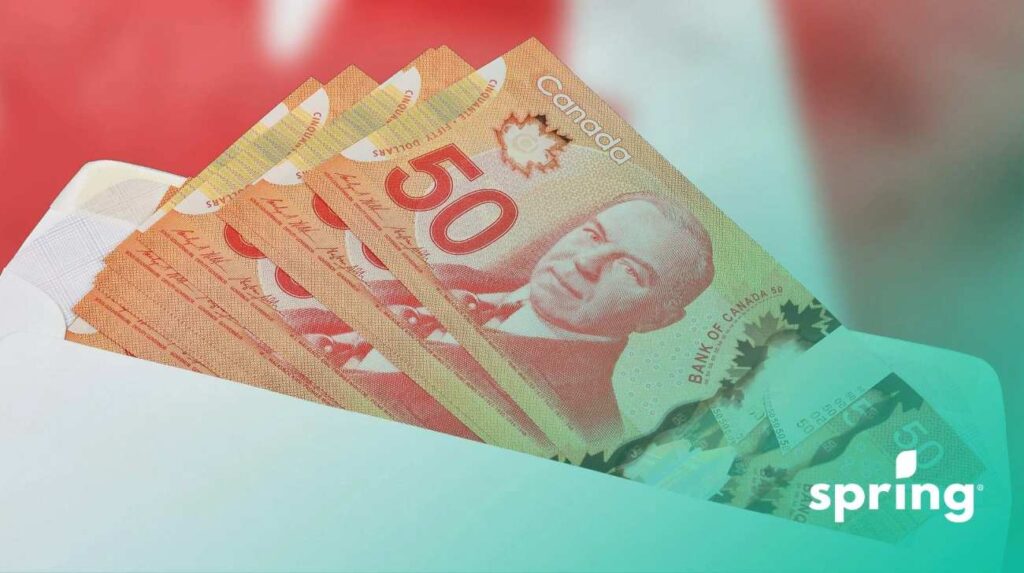The Envelope Saving Method
Throughout the years, countless saving enthusiasts and advisors have suggested a budgeting system that’s highly effective due to its simplicity. All you need to do is figure out your monthly discretionary expenses, set physical cash aside for those expenses in corresponding envelopes, and once there’s no money left in that envelope, your monthly spending is done. However, this only works if you do this with all the money you make every month. This is the basics of how to use budget envelopes.
The cash stuffing method works because you have no choice but to stop spending your money when there is nothing left. Critically important is how you’re effortlessly and always aware of what you have left. The key to doing this though, is to have enough money in your monthly income to cover everything.
Before we had digital transactions and instantly available credit, cash purchases were easier to track and register your spending habits. With now-common spending tools like tap-to-pay credit card technology and debit cards, we rarely see the immediate impact of our spending, nor do we notice what we have left.
When we lose track of our expenditure, we overspend. The cash envelope budgeting system prevents that. You will be in control of your money, instead of it controlling you. When you use the envelope system, your funds are tangible keeping you more accountable for your spending.
Another highly desirable benefit of using this system is that it will likely reduce your spending without creating as much temptation to overspend. People tend to spend less when they [have cash. If you have savings goals or other expenses that need to be covered, the envelope system can get you there sooner. Plus, you’ll enjoy fewer overdraft fees and less credit or debit card interest!
The self-awareness and discipline that you acquire will give you the confidence and skills to succeed with other financial goals, too. The envelope system will develop mindfulness about your spending and help you minimize splurges, impulse purchases, and other detrimental behaviour,s which will leave you with more money at the end of the month.
Getting Started With The Envelope System
While on the track to improve your financial health, it’s important you do the required steps before you start the envelope system.
Before you start:
- Track your spending to get an idea of where your money is going. Most banks and credit card companies have free online tracking software already running in the background. There are many great budgeting apps to help you, too. It’s a great place to start, short of manually recording every expense yourself.
- Check your calendar for upcoming expenditures and regular, fixed payments.
- Highlight any spending areas that are particularly problematic for you. If you only want to work with a couple of individual envelopes at first, pick the areas where you’re wasting the most money (i.e. clothes shopping or dining out.)
- Set ground rules for the system, especially if more than one member will be responsible for family spending. You need to consider who will need to carry the envelope(s) for each category, what to do about emergency spending, and what happens if you run out of money in a category.
- Prepare to make adjustments to your plan; nobody gets it right the first time!
Determine How Much Of Your Total Budget Goes Into Envelope
To achieve success with an envelope system, ensure that your budget reflects your needs in a realistic, manageable way.
Distinguish between your fixed expenses which are unchanging, and your discretionary expenses. In the digital age we live in, you likely won’t need to create an envelope system for “fixed expenses.” Since many, if not all of them, can be deducted straight from your bank account (mortgage, insurance, utilities, car payment, loans), it’s taken care of for you.
It’s always a good idea to set up automatic withdrawals for any debt you owe so that you won’t accidentally spend from those envelopes. If you don’t have automatic withdrawals set up for regular, fixed payments, they need to be part of your cash envelope system.
Once you’ve deducted your fixed expenses from your monthly net income, the amount remaining becomes the basis of your Cash Envelope System – for necessary and optional expenses.
Next, you need to assign spending categories.
Choose Spending Categories
This is where you figure out just how many envelopes you’ll need. Start with the categories you have the most trouble with. For example, when you review your previous expenses and spending patterns, you might find that you spend far too much money dining out. You might want to start there. Set a monthly budget for dining out and stick to it! Remember, if you greatly reduce your eating-out costs, you might need to allocate a little more to your groceries fund, but as long as you’re making savings in the long run, that’s okay!
For categorization, colour coding might help! For example, green (means go) for different “necessity” categories and yellow (be-prepared-to-stop light) for optional expenses. You can even just choose to write a category on the back of the envelope.
Here are essential categories for you to consider:
- Groceries: every saver will have a grocery envelope for their grocery store fund
- Transportation: gas, public transit, Uber/Lyft
- Clothing: shoes, clothes, dry-cleaning, growing kids
- Entertainment: movies, eating out
- Miscellaneous: unexpected guests, forgotten birthdays, car repairs, haircuts
- Me: a little treat,for a successful envelope-budget month
Some people prefer a monthly system, yet for others, filling the envelopes at every pay period works far better. Both approaches work, so pick the one that best suits your circumstances. Either way, keep in mind that when you pull money from other labeled envelopes it can hinder your savings goals.
Allocate The Right Amount Of Cash Into Each Envelope
If you’ve never tracked your expenses before and don’t know where to start, the highly recommended 50-30-20 budgeting rule provides a good foundation on where your money should be going. All the cash that you withdraw for your envelopes should not include savings or fixed expenses for things like rent, bills, etc. Even credit card debt payments should be separate. You don’t need to withdraw money or use actual cash for these expenses.
Use the information gathered from tracking your expenses to figure out how much you should allocate to each envelope every month. You might not get it perfect on your first try, but don’t be discouraged! Simply tweak the categories and amounts in the following months until you have a system that works for you and allows you to budget money.

The Envelope System Without Cash
Digital envelopes can be a bit tricky since digital transactions aren’t as painful as having to fork over crisp dollar bills. But if you want to take advantage of those sweet card rewards points, you can employ the envelope system for your digital finances, too.
Here are two options to try:
Option A:
- Open different checking accounts and savings accounts for each category. If they’re at the same bank, you can transfer money around quickly. If that easy accessibility is too tempting, make it harder with accounts in different banks.
- Assign each account or credit card to one of your categories.
- Next, load each account with the money for that ‘envelope.’
- Then, you will need to select the correct debit or credit card at each purchase. Be very strict with yourself about paying in full, any credit card charges as soon as your monthly statement arrives, to stay on track.
Option B:
- Mvelopes is an Android- and Mac-friendly app that manages your envelope budget system once you’ve set it up. Its flexible and customizable features let you link to many different banks, PayPal, and credit card accounts. You can assign “money” and accounts for each category, and Mvelopes tracks your spending. You can even assign manual payments. Various levels of service are available.
Remember: Cash envelopes can only work if you avoid borrowing from other envelopes, so a little discipline is important from the get-go if you want to form good practices and see fast results.
If you do stick to the plan, the cash envelope budgeting system provides a quick and effective solution to overspending. Feel free to adjust your envelopes until it works for you, but you’ll soon see that a few paper envelopes and a little perseverance will make all the difference to your finances. This is the case whether you choose to use physical or digital envelopes. While physical envelopes are simpler to manage, you still get a lot of financial freedom with virtual envelopes.
Alternatives To The Envelope System
While the envelope system is a great way to control your finances, it isn’t the only option. Here are a few other ways that you can regulate your spending and increase your savings.
Automate Your Account
One of the simplest ways to automate your bank account. You can assign a certain amount to each bill every month, as well as any savings or retirement accounts you want to contribute to. Essentially, you can set it up so all that’s left in your account is your spending money for variable expenses. This isn’t quite the same as the envelope method, but it ensures you only use what you have.
Use Cash
Another way to control your spending is to only carry cash for your spending money. The money in your account is allocated for bills and savings only. If you only have a certain amount of money to spend that you can see in your hands, you’re less likely to go over budget. It’s similar to how envelope budgeting works, but you don’t have to split up the funds; you just use what you have for whatever you need. As long as you have enough cash, it’s similar to using just one envelope to develop better financial habits. Any leftover cash can be forwarded to the next month’s spending money.
Use Budgeting Apps
If you’d prefer a more tech savvy approach to organizing your finances then a really good option is a budgeting app. These apps link to your bank account and allow you to track your expenses as well as manage them. You don’t have to worry about carrying cash but you can still control spending.
When it comes to budgeting apps, there are so many to choose from. Each one has its own strengths, and which one you choose should reflect the most important aspects of budgeting for you. If you think these apps cost a fortune, though, that’s where you’re wrong. Many of these apps offer a free version as well as paid version, so you can choose which version works best for you.
With budgeting apps, you can create budget categories. These are similar to envelope categories without all the envelopes. They allow you to gain control, but you do have to do your own worth since there’s nothing to keep you accountable. The fact these apps track your bank statements, though, allows you to find extra cash in a less time-consuming way.
Final Thoughts
The envelope saving method is a popular way to save money. That said, not many people prefer to use cash. In that cash, there’s always the electronic version of the envelope method. No matter which one you choose to use, it gives you a clear cut spending limit that holds you accountable.
Before you decide to settle on a budgeting method, it’s important to know that the envelope method isn’t the only one out there. There are plenty of other ways that you can budget your money including budgeting apps, account automation as well as using cash. There are even other budgeting methods out there like the zero based budget which can also help you find more cash. The best thing you can do to set yourself up for financial success is to use the best method that works for you.








